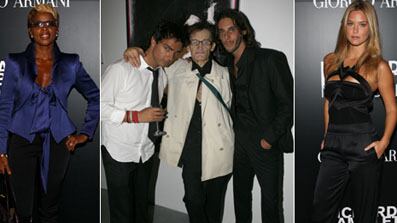The show of paintings by Richard Hambleton which opened in a 12,000-square foot space on Washington Street on New York’s Meatpacking District on September 15 demands attention for two very different reasons. One is that the opening was slapbang in the middle of Fashion Week and this was is no accident. Andrew Valmorbida, an Australian, the heir to a billion dollar fortune, and no stranger to the international party circuit, was the prime mover in putting it together; his partner Vladimir Restoin Roitfeld is the son of Carine Roitfeld, editor of French Vogue; and Giorgio Armani took a hand in producing the show. So it’s clear that it’s just what the art world needs from time to time: An event.
Click Image Below to View Our Gallery

The show demands attention though for more substantial reasons and Hambleton is very far from any conventional notion of what might constitute a “fashionable” artist. One of the more distinctive talents to emerge from the Lower East Side in the mid 1970s, the Canadian-born New Yorker first came to attention for the public art he was making at the same time as Keith Haring, Jean-Michel Basquiat aka “Samo,” Jenny Holzer, and the graffitti artists like Futura 2000, Ramellzee, Lady Pink and Daze, who were doing their wholly illegal stuff on the subway trains.
Between 1976 and 1979, Hambleton was chalking human outlines on the ground on streets of New York where nobody had in fact been killed. That series was called Image Mass Murder. In the early ‘80s he switched to making wall paintings, life-size human silhouettes, built from explosively spiky slashes of black paint. He put these on walls not just in New York, but London, Rome, Paris and on the Berlin Wall. But it was Shadowman that made him famous.
Hambleton moved on to painting on canvas, making subversively beautiful work, which was remarkable because he had a bad drug habit. But he contrived to put even this to constructive use, as when he sheafed a series of small square canvases in gold paint upon which he traced what looked like abstracted landscapes in dark red, which seemed energy-charged, even before you discovered that the art material was the artist’s own blood.
Hambleton’s work never wholly disappeared – he had a show at the now defunct Magidson Gallery on the Upper East Side a few years ago – but it is overdue for the attention that will now come its way in the crucible of Fashion Week. The prime mover behind the show, Andy Valmorbida, who is now 30, moved with his family to Manhattan when he was in his mid teens. He notes that he “loved art” and started going to gallery openings. Which he loved a great deal less. “They were so boring,” he says. “A lot of people drinking white wine and talking.”
The word “boring” is key here.
Valmorbida decided that a new generation of collectors and potential collectors were used to parties with more production values, the kind of thing laid on in the worlds of fashion and marketing, and he decided to fill this glaring hole. His launchpad was a party in his apartment on 71st and Madison for Ralph Mazzucco, a fashion photographer who makes paintings. This was December 2006. “The party started at 6 p.m. and ended at three in the morning,” he notes. It was replete with bold-face names. “A lot of celebrities, supermodels, blah blah blah. And the press the next day went crazy over it.”
Moreover, he sold 24 paintings that evening. “Then I took the show straight to LA … then I did a show in the Hamptons … then I took it to Australia … “ he says. He also set up a private dealership, Valmorbida & Co, designed to shake things up by bringing “event-marketing” methods to the business of selling art.
Valmorbida was introduced to Richard Hambleton’s work by a New York dealer, Victor Librizzi. “Richard used to sell art from his studio to people that he knew. And he let very few people in,” Valmorbida says. “Victor Librizzi was one of the few he let in. Victor was accumulating many works by Richard.”
It was Librizzi’s son Nemo who took Valmorbida to the studio. That was just nine months ago. “And from that day on I dropped every art project and worked on this fulltime,” he says. “I put a strong team together to relaunch him. Richard has not cooperated in a show since 1985. But I worked with Richard closely and had his full cooperation for this show.”
The Fashion Week opening is, of course, very much a Valmorbida & Co. production, as was the Giorgio Armani connection. “My partner Vladimir knew that Giorgio had been looking for an artist to work with for years.”
Armani was shown the work and loved it. He also clearly saw in a connection with Hambleton’s art a way to differentiate himself from the fashion pack. “There are fifty parties. All the major brands. And it’s always the same boring people,” Valmorbida says. “It’s very good for the brand.”
A few hours before the official opening party—attended by Alicia Keys, Josh Hartnett, Mary J. Blige, among others—he told me, “Ninety percent of the show is sold.” (The show has since sold out.) There had already been a private party attended by Bruce Willis and photographer Patrick Demarchelier. And Lisa de Kooning had bought a piece and praised the project. “She was raving about the energy,” Valmorbida says. “She told me it reminded her of the ‘70s.”
Valmorbida says he plans a Hambleton show in London in February and March. Then others. The Giorgio Armani connection will be maintained. Indeed Valmorbida sees no reason whatsoever to alter the business plan.
The Richard Hambleton show is a great leap forward. Clearly Valmorbida and Vladimir Restoin Roitfeld are targeting a huge and influential chunk of the culture. And certainly also this overlap of art and fashion is another sign of one of the principal characteristics of the times: Cultural melt.
Plus: Check out Art Beast, for galleries, interviews with artists, and photos from the hottest parties.
Anthony Haden-Guest is the news editor of Charles Saatchi’s online magazine.






